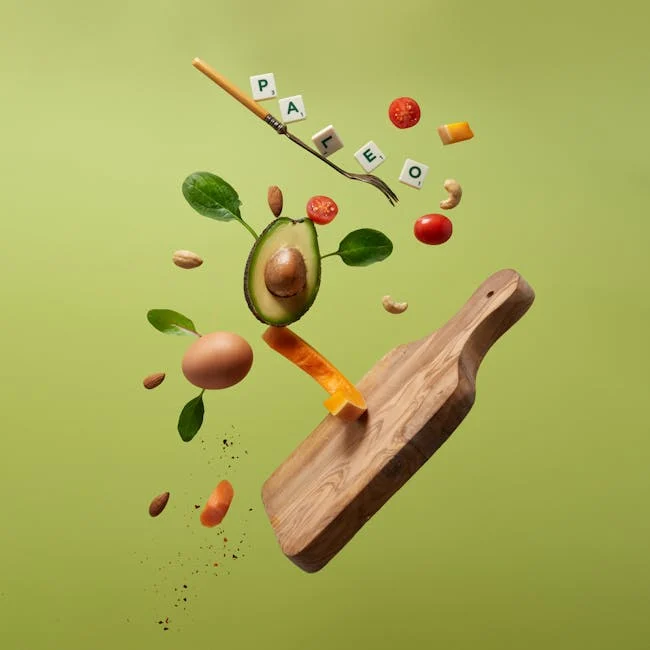Introduction
The Paleo diet, often misunderstood as a restrictive caveman eating plan, actually encourages a far wider variety of nutrient-dense foods than many modern diets dominated by processed and refined options. While eliminating grains, legumes, and dairy, Paleo opens the door to a vast landscape of vegetables, fruits, meats, seafood, nuts, and seeds, fostering a greater intake of essential vitamins and minerals often lacking in contemporary meals. This article will explore how the Paleo diet promotes food variety and micronutrient density, contrasting it with the pitfalls of modern dietary patterns.
Paleo’s Focus on Food Variety and Micronutrient Density
Embracing a Spectrum of Vegetables and Fruits
Modern diets frequently lack sufficient servings of vegetables and fruits, often favoring processed carbohydrates and sugary snacks. The Paleo diet emphasizes a wide array of colorful vegetables and fruits, each offering a unique profile of vitamins, minerals, antioxidants, and fiber. This emphasis leads to:
- Increased Vitamin Intake: Dark leafy greens provide vitamins A, C, and K, while colorful bell peppers offer vitamin C and carotenoids.
- Enhanced Mineral Consumption: Potassium from sweet potatoes, magnesium from spinach, and folate from asparagus are readily available.
- Fiber-Rich Options: Non-starchy vegetables like broccoli, cauliflower, and Brussels sprouts promote gut health and satiety.
- Antioxidant Powerhouses: Berries, such as blueberries, raspberries, and strawberries, are packed with antioxidants that combat oxidative stress.
Prioritizing High-Quality Protein Sources
Paleo prioritizes nutrient-dense protein sources, moving away from processed meats and excessive reliance on factory-farmed options. This focus leads to:
- Lean Meats: Grass-fed beef, bison, and lamb provide essential amino acids and healthy fats.
- Seafood Abundance: Wild-caught salmon, tuna, and shellfish are excellent sources of omega-3 fatty acids, vitamin D, and selenium.
- Poultry Variety: Free-range chicken and turkey offer lean protein and essential nutrients.
- Organ Meats (Optional): Liver, heart, and kidneys are incredibly nutrient-dense, providing high concentrations of vitamins and minerals, though consumption is not essential for a Paleo diet.
Nuts and Seeds for Healthy Fats and Minerals
Unlike diets reliant on unhealthy trans fats and processed vegetable oils, Paleo incorporates nuts and seeds as sources of healthy fats, vitamins, and minerals:
- Healthy Fats: Almonds, walnuts, and avocados provide monounsaturated and polyunsaturated fats essential for hormone production and brain health.
- Vitamin E: Almonds and sunflower seeds are good sources of vitamin E, an important antioxidant.
- Magnesium and Zinc: Pumpkin seeds and cashews are rich in magnesium and zinc, crucial for various bodily functions.
Avoiding Processed Foods and Refined Sugars
One of the most significant benefits of the Paleo diet is the elimination of processed foods, refined sugars, and artificial additives, which are often devoid of nutritional value and can contribute to inflammation and chronic diseases. This avoidance naturally increases micronutrient intake from whole, unprocessed foods.
- Reduces Empty Calories: Eliminating sugary drinks and processed snacks reduces empty calorie intake.
- Minimizes Artificial Additives: Avoiding artificial colors, flavors, and preservatives reduces exposure to potentially harmful chemicals.
- Promotes Satiety: Whole foods are more satiating than processed foods, leading to better portion control and nutrient absorption.
Contrasting Paleo with Modern Dietary Patterns
The Standard American Diet (SAD)
The Standard American Diet, often high in processed foods, refined grains, and sugary drinks, frequently falls short in providing adequate micronutrients. This can lead to nutrient deficiencies and increased risk of chronic diseases.
Vegetarian and Vegan Diets (Potential Deficiencies)
While vegetarian and vegan diets can be healthy, they require careful planning to ensure adequate intake of certain nutrients, such as vitamin B12, iron, and omega-3 fatty acids, which are more readily available in animal products. Paleo, with its emphasis on meat, seafood, and nuts, naturally provides these nutrients (although Paleo excludes legumes which can be a good source of iron and other nutrients for vegetarians/vegans).
Conclusion
The Paleo diet, when implemented thoughtfully, encourages a rich and varied intake of nutrient-dense foods, leading to improved micronutrient status compared to many modern diets. By focusing on vegetables, fruits, high-quality protein sources, and healthy fats, and by eliminating processed foods and refined sugars, Paleo promotes a dietary pattern that supports optimal health and well-being. While individual needs may vary, the core principles of Paleo offer a framework for building a more nutrient-rich and satisfying eating lifestyle.
